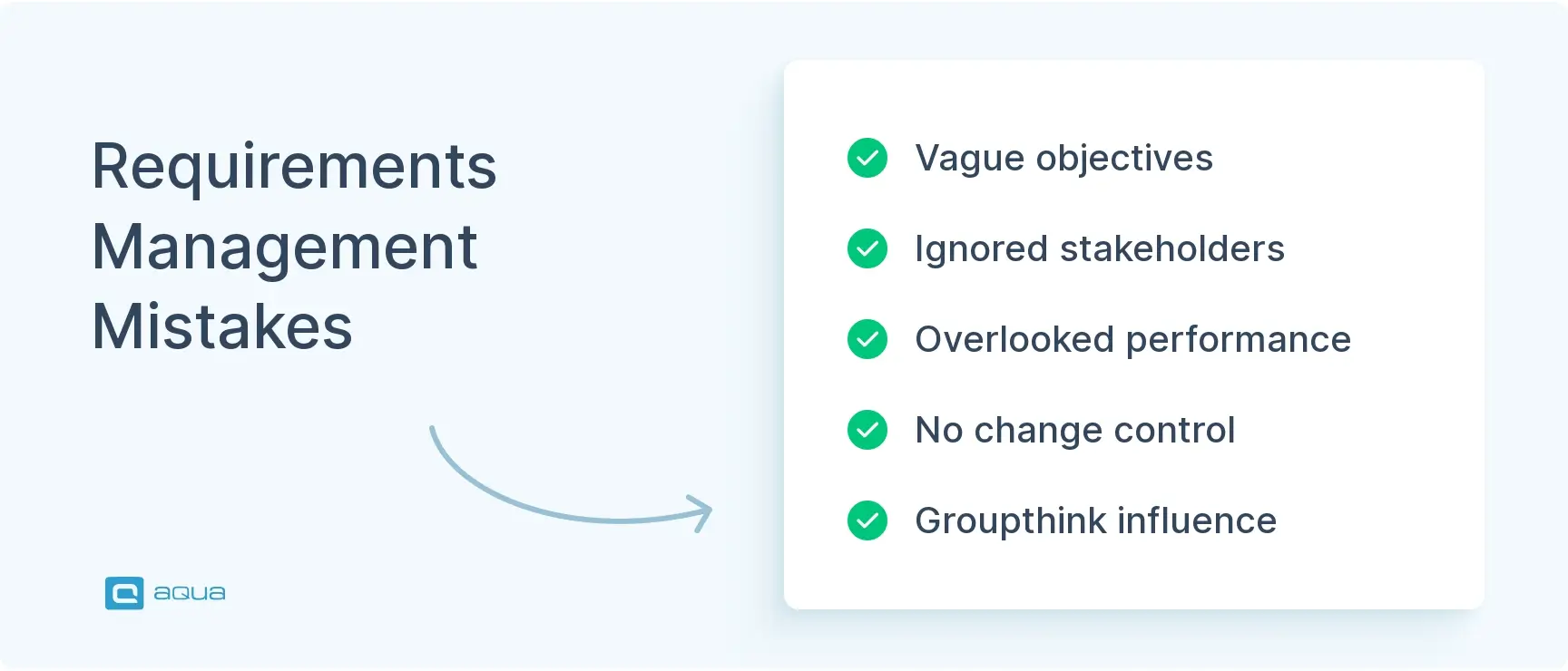Key Takeaways
- Requirements management failures are the root cause of approximately 78% of project failures. Fixes cost 10-100 times more when caught late versus early detection.
- Non-functional requirements like performance and scalability are overlooked in 48% of ICT projects. It creates systems that meet functional specs but fail under real-world conditions.
- Cognitive biases, including confirmation bias, anchoring, and groupthink, hurt requirements gathering and lead to flawed decision-making.
- Vague objectives like “user-friendly” or “load quickly” create expensive misalignments. An inventory system failed when developers built for 100 users, but clients expected 1,000+.
- Effective requirements management requires diverse stakeholder involvement, precise documentation, test-driven validation, and formal change control processes to prevent scope creep.
That inventory system miscommunication cost $300,000 in unplanned work, and it’s just one example of how requirements mistakes silently drain budgets before a line of code is written. Discover the biases sabotaging your projects and strategies to prevent these disasters 👇
The Importance of Effective Requirements Management
Requirements management determines whether you build what people need or waste money on features nobody wants. Poor requirements management leads to scope creep that turns six-month projects into eighteen-month disasters. You deal with rework cycles that could have been prevented with clearer specs upfront. You ship products that miss the market because nobody validated what customers actually wanted.
The cost of getting it wrong
Fixing a requirements defect during development costs roughly 10 times more than catching it early. Waiting until production? You’re looking at 100 times the original cost.
A software firm might build an inventory system with a vague requirement about “supporting many simultaneous users.” The dev team thinks of 100 concurrent users. The client expects over 1,000. The misalignment occurs after deployment, costing an extra $300,000 and four months of unplanned work.
Performance issues nobody plans for
Gartner research shows 48% of ICT projects experience performance issues because of a simple mistake: treating non-functional requirements like scalability as afterthoughts.
Teams focus on what features do. They forget how well features need to perform.
When this happens:
- Systems buckle under real-world load
- Security vulnerabilities expose customer data
- Compliance failures trigger regulatory penalties
Strong requirements management doesn’t guarantee success. Weak requirements management practically guarantees expensive failure.
Understanding Behavioral Biases in Requirements Management
Your brain sabotages you during requirements gathering. Not intentionally, but systematically through cognitive biases that distort judgment. Let’s look at these biases practically, and you will surely recognize at least some of them.
Fundamental understanding helps a ton. The worst requirements gatherers are the keepers of sentence fragments, shuttling strings of 10-20 words between people like they are engraved on stone tablets.
Also, assume nothing. Assumptions are where requirements get missed. My best BA asks 10 stupid questions and the 11th catches something we missed.
Confirmation bias makes you hear what you want
You already know the solution you want. During stakeholder sessions, you notice feedback that supports your approach. You unconsciously filter out contradictory evidence. A stakeholder pushes requirements aligned with her technological preferences while ignoring critical platform stability needs. The resulting system fails to meet core business objectives because one person’s confirmation bias drove the entire process.
Anchoring bias locks you into the first idea
Someone mentions a competitor’s feature in an early meeting. That anchor dominates every subsequent discussion. A business analyst redesigning a customer service portal initially anchored on replicating a competitor’s interface after someone praised its simplicity. That anchor nearly prevented the team from discovering their customers needed functionality the competitor lacked. They broke free only by deliberately seeking broader input. Most teams never escape that initial anchor.
What if you could systematically prevent these requirements disasters before they happen? aqua cloud’s requirements management system directly addresses the behavioral biases and common mistakes outlined above. With AI-powered requirements creation, you can generate clear, testable requirements that eliminate the vagueness problem while maintaining complete traceability between requirements and test cases. Unlike traditional tools, aqua’s domain-trained AI Copilot with RAG grounding learns from your project’s documentation, ensuring requirements reflect your specific context and terminology. This means your AI actually understands your project’s unique language and needs and dramatically reduces misinterpretation risks.
Transform your requirements management from a vulnerability into your competitive advantage with aqua
The availability simplification overvalues recent information
A competitor suffers a data breach. Suddenly, your team fixates on security requirements to the exclusion of everything else. That’s not strategic prioritization. That’s a clear bias.
Being obsessed with security after learning about a competitor’s breach can have massive consequences. You will create an unbalanced resource allocation that neglects other critical requirements. Your project will fail because of this cloud in your judgement.
Overconfidence bias creates the planning fallacy
Sometimes, project managers skip necessary reviews, believing their initial judgments are solid. They provide optimistic timelines based on best-case scenarios. They ignore the inevitable uncertainties that can harm every project. Teams underestimate both task complexity and integration challenges, then act shocked when reality doesn’t match their rosy projections.
Groupthink kills good requirements
If you feel maintaining team harmony becomes more important than making good decisions, spend some time alone. Because in this case, dissenting opinions get suppressed. People stay quiet rather than risk conflict.
Mostly, organizations collectively prioritize security over all other considerations without thorough analysis. Not because security isn’t important, but because the desire for consensus prevents critical evaluation of trade-offs. Teams make biased decisions that feel unanimous but are actually just unchallenged.
These biases compound each other. They create flawed requirements that seem perfectly reasonable until the project implodes.
Common Mistakes in Requirements Gathering
Vague objectives leave everyone guessing
When requirements say “the system should be user-friendly” or “load quickly,” you’re asking developers to read minds. Different stakeholders interpret those phrases completely differently based on their own experiences.
Clear requirements need specific metrics: “The system should load within 3 seconds under normal load conditions (1,000 concurrent users on a T1 connection).” That’s testable. That’s unambiguous. Anything less sets you up for expensive surprises.
Stakeholder involvement that’s too little, too late
You can’t gather solid requirements by talking to three people and calling it good. Stakeholders (including actual end users, not just their managers) possess insights you’ll never discover otherwise. When engagement stays shallow or happens too late, critical needs stay buried until they surface as defects mid-development.
Limited stakeholder participation amplifies groupthink within your core team. Without diverse perspectives challenging assumptions, confirmation bias runs wild. Teams build what they think stakeholders want rather than what stakeholders actually need, then act surprised when adoption tanks.
The hidden stakeholder problem nobody addresses
Some stakeholders don’t even make it onto your radar until they’re blocking deployment or demanding late-stage changes. You should see them as more than a nice-to-have voice. They’re people with legitimate stakes in your project who got overlooked during initial planning.
Maybe it’s a compliance officer whose regulatory requirements never made the requirements doc. Maybe it’s a vendor whose integration needs weren’t considered. Discovering them three weeks before launch creates chaos. Unspoken requirements emerging near completion force costly rework. They also create conflicts between stakeholder groups who should’ve been aligned from day one.
Non-functional requirements treated like optional add-ons
Teams obsess over functional requirements (what the system does) while treating quality, performance, scalability, and security as secondary concerns. That’s backwards. Non-functional requirements determine whether your system actually works in production.
“The system should load quickly” is wishful thinking. You need “The system should maintain sub 3 second response times with 1,000 concurrent users and 10 million records in the database.” You need uptime targets, disaster recovery expectations, encryption standards, and compliance specifications.
Neglecting these produces systems that technically meet functional specs but collapse under real-world conditions.
Change management chaos where scope creep runs wild
Without structured processes for evaluating and approving changes, requirements multiply like rabbits. New features get added weekly without a formal assessment of their impact on cost, timeline, or quality. Nobody tracks requirement versions. Decisions about what’s in or out of scope happen in hallway conversations rather than documented reviews.
A $68 million CRM rollout started drowning in changes within three months. New requirements flooding in weekly, business units requesting unplanned customizations, and leadership pushing expanded functionality. The project implemented a formal Change Control Board reviewing all changes with proper impact assessments.
While they exceeded the original budget by 20%, that disciplined approach recovered 50% of lost time and delivered 90% of core objectives plus high-priority additions. Without it? That project would’ve collapsed entirely under unchecked scope expansion. Following strategies for requirements management prevents this kind of chaos from taking over.

Strategies to Avoid Requirements Management Mistakes
Now it’s time to help you get out or prevent all these situations from happening.
Diversify your stakeholder conversations from day one
You need voices from different departments, different roles, different organizational levels, all contributing to requirements. That diversity directly counters confirmation bias and groupthink.
Run multi-stakeholder workshops where people collaborate on identifying needs rather than siloing discussions. Use techniques like Six Thinking Hats to encourage multiple viewpoints. Rotate who facilitates meetings so no single person dominates. Collect anonymous feedback through surveys when social pressure might suppress honest opinions. Bring in external reviewers who aren’t invested in any particular outcome.
The more perspectives you incorporate, the harder it becomes for any single bias to distort your requirements.
Choose elicitation techniques that match your context
Interviews work great for exploring nuanced requirements with subject matter experts. Workshops excel when you need to align diverse stakeholder groups. Surveys help validate assumptions across broader populations. Prototyping reveals usability requirements that stakeholders can’t articulate in abstract discussions. Document analysis uncovers constraints and compliance needs buried in existing materials.
Don’t just default to whatever technique feels comfortable. Deliberately select methods based on what information you need, who has it, and how best to extract it.
Document with precision and maintain traceability
Use standardized templates, ensuring consistent format and terminology across all requirements. Write specific, testable, measurable statements rather than vague descriptions. Include acceptance criteria explicitly defining what constitutes requirement satisfaction. Document assumptions and rationale so your reasoning stays visible and challengeable later.
Modern traceability tools provide live views showing how requirements relate to design, test cases, and code. Impact analysis automatically reveals effects when requirements change. Its visibility prevents miscommunication and enables informed decisions.
Test your requirements before writing code
Create test cases for each requirement during the requirements phase. If you can’t design a valid test case, that requirement is incomplete, vague, or flawed. This Test-Case-Driven Inspection approach forces precision.
“The system should load quickly”, can’t generate a test case.
“The system should load within 3 seconds under normal load conditions” absolutely can.
Testers collaborating with product managers and stakeholders during requirement reviews catch ambiguities immediately rather than discovering them mid-development.
Fixing requirements defects costs a fraction during this phase compared to post-deployment fixes. We’re talking 100 times cost differences. Early validation through testing catches problems when they’re cheapest to fix.
Implement formal change control that actually works
Establish a Change Control Board with multi-disciplinary representation, evaluating all requested changes. Run impact assessments analyzing effects on cost, timeline, quality, and resources before approving anything. Document every change request, evaluation, and decision. Lock down your approved scope baseline and protect it.
Maintain a single point of contact for stakeholder communication to minimize conflicting demands. Regular stakeholder meetings keep everyone aligned on objectives and priorities.
Discipline beats chaos every time.
Balance Agile flexibility with requirements rigor
Write user stories with rich, testable acceptance criteria. Conduct regular backlog refinement sessions, ensuring quality and clarity before items reach sprints. Set clear sprint goals providing focus and preventing drift. Maintain continuous stakeholder engagement through regular review sessions. Define explicit “done” criteria preventing completion disputes. Deliver small, valuable increments, allowing frequent validation and feedback.
Recognize and actively avoid Agile anti-patterns like:
- Dominant Product Owners making solo decisions
- Missing acceptance criteria
- Mid-sprint scope changes
- insufficient stakeholder review
The Agile Manifesto values responsiveness to change. It doesn’t eliminate the need for requirements discipline. Shift from waterfall’s “all requirements upfront” to Agile’s “continuous requirements refinement with evolving clarity,” but keep the rigor and learn the key benefits of requirements management.
Requirements management pitfalls might be human problems, but they require systematic solutions. aqua cloud delivers precisely that: a comprehensive platform that addresses each challenge mentioned in this article. With flexible hierarchy structures supporting both Agile and Waterfall methodologies, aqua adapts to your preferred workflow rather than forcing you into rigid processes. The platform’s risk-based prioritization helps you focus resources where they matter most, while banking-grade traceability ensures nothing falls through the cracks. Particularly powerful is aqua’s AI Copilot with RAG grounding technology, which uses your own documentation to generate project-specific, contextually accurate requirements and test cases – saving up to 97% of time while maintaining the highest quality standards. The built-in change control capabilities prevent scope creep, while real-time dashboards provide the transparency needed to keep stakeholders aligned. By implementing aqua, you will eliminate the cognitive biases and process failures that derail projects.
Achieve 100% requirements coverage and reduce project failures by 78% with intelligent test management
Conclusion
Requirements management failures trace back to cognitive biases you can easily prevent. Confirmation bias makes you hear what you want. Anchoring locks you into the first idea someone mentions. Overconfidence creates unrealistic timelines. These biases get worse when you misinterpret Agile as needing no structure and let projects drift. Poor requirements management causes most project failures, but this is avoidable. Diverse stakeholder engagement catches blind spots. Effective elicitation techniques surface real needs. Early testing-based validation catches problems cheaply. Disciplined change control prevents scope creep. Apply strategies for requirements management and turn requirements from your biggest risk into your competitive advantage.

















